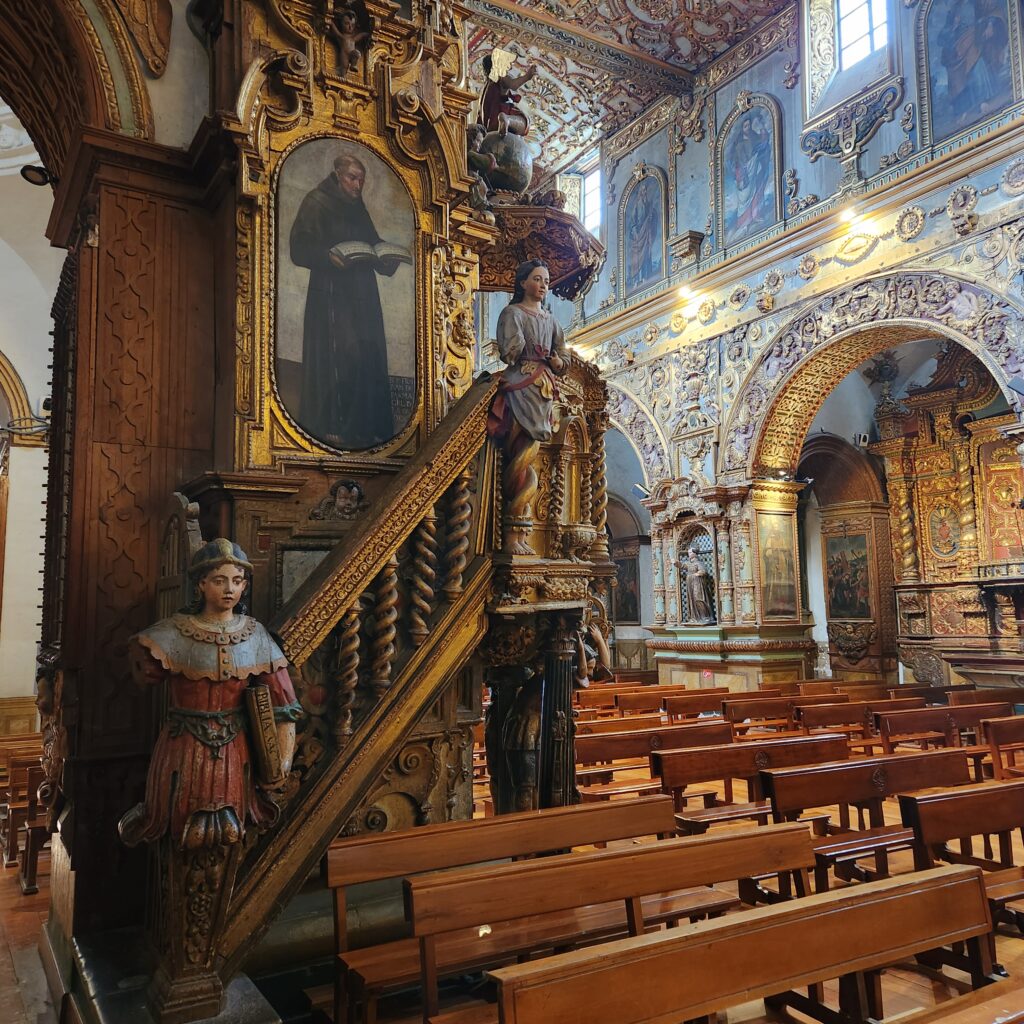La iglesia de San Francisco presenta un interior de gran riqueza artística y arquitectónica, organizado en tres naves con planta de cruz latina. Desde el siglo XVII se destacó por su imponente descripción: una nave central cubierta por un artesonado dorado de cedro, capillas con bóvedas y linternas que iluminaban retablos dorados, y un crucero de gran elegancia. El coro, con 81 sillas talladas en cedro y dos órganos, resaltaba por su calidad musical y ornamental. Aunque algunos elementos fueron sustituidos tras el terremoto de 1755, la estructura general, los retablos y artesonados mudéjares se han mantenido como testimonio del esplendor original, lo que le valió el nombre de “El Escorial de los Andes”.
El presbiterio y las capillas son de las zonas más notables. El altar mayor, de estilo protobarroco, combina esculturas, relieves, espejos y plata, con la célebre Inmaculada de Bernardo de Legarda como pieza central. El crucero alberga capillas como la de Villacís y la de Santa Marta, con retablos ricamente decorados en madera dorada y policromada. Destacan los retablos barrocos de San Francisco de Asís y San Antonio de Padua, obras maestras de la Escuela Quiteña, con abundante simbolismo franciscano y esculturas de gran calidad como el grupo de la Asunción de la Virgen de Caspicara.
En su conjunto, el interior combina mudéjar, manierismo y barroco en una unidad sorprendente. Los artesonados dorados, los relieves policromados con motivos vegetales americanos y los retablos laterales platerescos evidencian la fusión de influencias artísticas. El coro, con su artesonado mudéjar estrellado y 75 sillas de cedro, era el centro de la música litúrgica franciscana. Con más de 3500 obras de arte, la iglesia de San Francisco constituye uno de los conjuntos más completos y representativos de la Escuela Quiteña, un espacio donde arquitectura, escultura y pintura se integran en una experiencia única de espiritualidad y arte.

The Church of San Francisco features an interior of great artistic and architectural richness, organized into three naves with a Latin cross layout. Since the 17th century, it has stood out for its imposing design: a central nave covered by a gilded cedar coffered ceiling, chapels with vaults and lanterns illuminating gilded altarpieces, and a transept of great elegance. The choir stalls, with 81 carved cedar stalls and two organs, stood out for its musical and ornamental quality. Although some elements were replaced after the 1755 earthquake, the overall structure, the altarpieces, and Mudejar coffered ceilings have been preserved as a testament to its original splendor, earning it the name «El Escorial de los Andes.»
The presbytery and chapels are among the most notable areas. The main altar, in proto-Baroque style, combines sculptures, reliefs, mirrors, and silver, with the famous Immaculate Conception by Bernardo de Legarda as its centerpiece. The transept houses chapels such as the Villacís and Santa Marta chapels, with richly decorated altarpieces in gilded and polychrome wood. Highlights include the Baroque altarpieces of Saint Francis of Assisi and Saint Anthony of Padua, masterpieces of the Quito School, with abundant Franciscan symbolism and high-quality sculptures such as the group of the Assumption of the Virgin of Caspicara.
Overall, the interior combines Mudejar, Mannerist, and Baroque styles in a striking unity. The gilded coffered ceilings, polychrome reliefs with American plant motifs, and Plateresque side altarpieces demonstrate the fusion of artistic influences. The choir stalls, with their star-shaped Mudejar coffered ceiling and 75 cedar stalls, were the center of Franciscan liturgical music. With more than 3,500 works of art, the Church of San Francisco constitutes one of the most complete and representative collections of the Quito School, a space where architecture, sculpture, and painting are integrated into a unique experience of spirituality and art.
